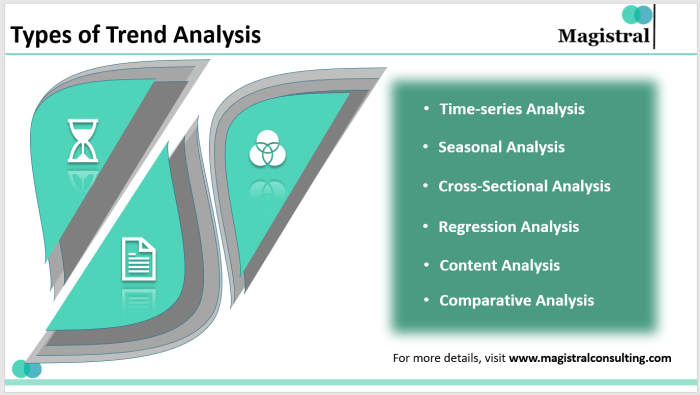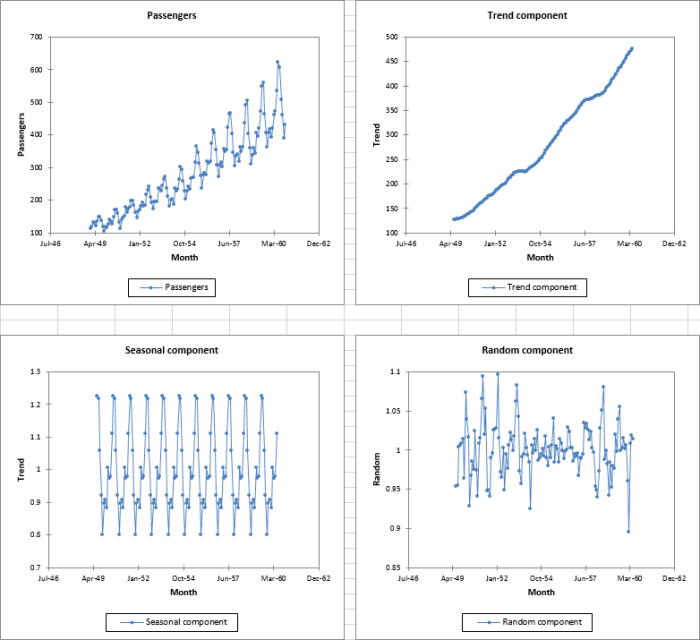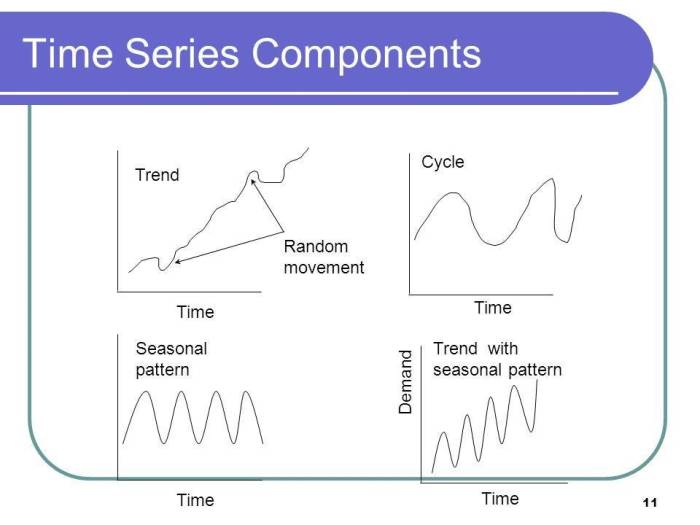Trend analysis and time-series analysis refer to analysis. – Trend analysis and time-series analysis refer to analysis techniques that empower organizations to decipher temporal patterns, uncover hidden trends, and make informed decisions. These powerful tools provide a comprehensive understanding of historical data, enabling businesses to anticipate future trends and optimize their strategies accordingly.
Trend analysis focuses on identifying long-term patterns and underlying trends in data, while time-series analysis delves into the statistical modeling of time-dependent data to forecast future values. By leveraging these techniques, organizations gain valuable insights into market dynamics, consumer behavior, and operational performance.
Trend Analysis

Trend analysis involves examining historical data to identify patterns and trends that can provide insights into future outcomes. It helps organizations understand the direction and magnitude of changes over time, enabling them to make informed decisions and anticipate market shifts.
Real-world examples of trend analysis include:
- Stock market analysts use trend analysis to predict future stock prices.
- Retailers use trend analysis to identify changing consumer preferences and adjust their product offerings accordingly.
- Healthcare providers use trend analysis to track disease prevalence and develop preventive measures.
Different types of trends include:
- Linear trends: A constant rate of change over time.
- Exponential trends: A constant percentage rate of change over time.
- Seasonal trends: Fluctuations that repeat over a specific period, such as daily or monthly.
Time-Series Analysis

Time-series analysis is a statistical technique used to analyze data that is collected over time. It aims to understand the underlying patterns and relationships within time-series data, enabling forecasting and decision-making.
Key concepts in time-series analysis include:
- Stationarity: The assumption that the statistical properties of a time series remain constant over time.
- Autocorrelation: The correlation between values in a time series at different time lags.
- Moving averages: A smoothing technique used to remove noise from a time series.
Methods used for time-series analysis include:
- ARIMA (Autoregressive Integrated Moving Average) models
- SARIMA (Seasonal Autoregressive Integrated Moving Average) models
- Exponential smoothing
Comparison of Trend Analysis and Time-Series Analysis: Trend Analysis And Time-series Analysis Refer To Analysis.
| Characteristic | Trend Analysis | Time-Series Analysis |
|---|---|---|
| Focus | Identifying general trends over time | Analyzing patterns within time-series data |
| Data | Historical data, often non-time-dependent | Time-series data, collected over time |
| Methods | Graphical analysis, moving averages | Statistical models (ARIMA, SARIMA, etc.) |
| Applications | Market forecasting, identifying long-term trends | Forecasting, anomaly detection, decision-making |
| Limitations | Can be subjective, may not capture short-term fluctuations | Assumes stationarity, may not be suitable for non-linear trends |
Similarities between trend analysis and time-series analysis include their use of historical data to gain insights into future outcomes. However, trend analysis focuses on identifying general trends, while time-series analysis is more concerned with analyzing patterns within time-series data.
Applications of Trend Analysis and Time-Series Analysis

Trend analysis and time-series analysis find applications in various industries, including:
- Finance: Forecasting stock prices, predicting market trends
- Retail: Identifying consumer preferences, optimizing inventory levels
- Healthcare: Tracking disease prevalence, developing preventive measures
- Manufacturing: Predicting demand, optimizing production schedules
- Environmental science: Monitoring climate change, forecasting natural disasters
Case studies of successful applications include:
- Walmart uses trend analysis to identify changing consumer preferences and adjust its product offerings.
- Amazon uses time-series analysis to forecast demand and optimize its inventory levels.
- The Centers for Disease Control and Prevention (CDC) uses time-series analysis to track disease prevalence and develop preventive measures.
Benefits of using trend analysis and time-series analysis include improved forecasting accuracy, better decision-making, and increased understanding of market trends.
Question Bank
What is the difference between trend analysis and time-series analysis?
Trend analysis identifies long-term patterns in data, while time-series analysis focuses on modeling time-dependent data to forecast future values.
What are the benefits of using trend analysis and time-series analysis?
These techniques provide valuable insights into market dynamics, consumer behavior, and operational performance, enabling organizations to make informed decisions and optimize their strategies.
How can businesses leverage trend analysis and time-series analysis?
By harnessing these techniques, businesses can anticipate future trends, optimize their operations, and gain a competitive advantage in the marketplace.